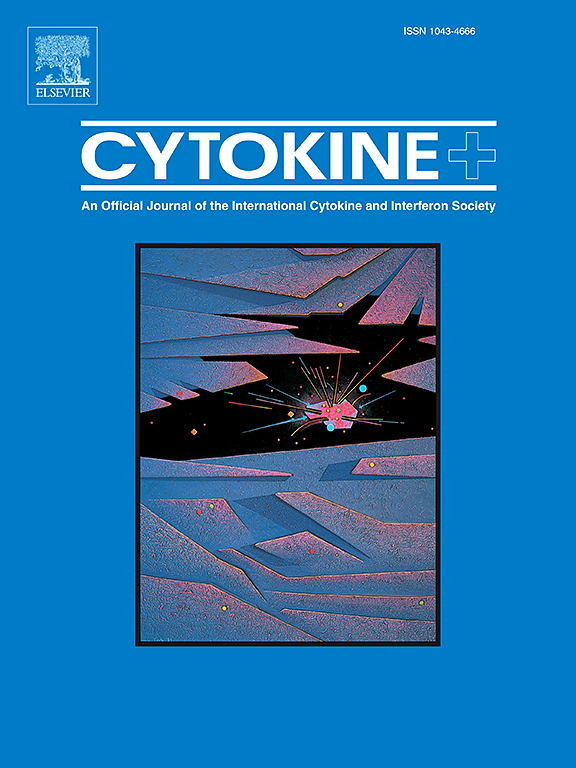循环炎症细胞因子与主动脉狭窄风险:孟德尔随机分析
IF 3.7
3区 医学
Q2 BIOCHEMISTRY & MOLECULAR BIOLOGY
引用次数: 0
摘要
背景:观察性研究一致报道炎症生物标志物与主动脉瓣狭窄(AS)发生风险呈正相关。然而,必须承认的是,传统的观察性研究容易出现各种形式的偏差,包括反向因果关系和残留混淆。为了更深入地揭示炎症生物标志物与主动脉狭窄之间的潜在因果关系,我们进行了一项全面的双样本孟德尔随机化(MR)分析。方法为了探讨暴露于各种循环细胞因子与AS发生风险的因果关系,我们从FinnGen进行的全基因组关联研究(GWAS)的汇总统计中精心选择了AS数据集作为暴露量。该数据集包括3283例AS病例和210,463例对照的样本量。为了估计MR分析,我们主要采用逆方差加权(IVW)方法。此外,我们采用加权中位数、MR Egger、加权模式和简单模式等互补方法对因果关系进行综合分析。为了评估异质性的存在,我们使用了Cochran's Q统计和MR-Egger回归。为了确保研究结果的稳健性和一致性,我们进行了留一分析。结果观察到白细胞介素-18 (IL-18)水平与AS呈正相关(比值比[OR] /标准差[SD] = 1.080;95%置信区间[CI] 1.024至1.139),以及干扰素-γ水平(IFN-γ)与as之间的差异(OR per SD = 1.157;95% CI 1.028 - 1.302)。相反,我们发现白细胞介素-13 (IL-13)水平与AS呈负相关(OR / SD = 0.942;95% CI 0.890 ~ 0.997),以及白细胞介素-5 (IL-5)水平与as之间的差异(OR per SD = 0.892;95% CI 0.804 ~ 0.990)。结论我们的研究增强了目前对特定炎症生物标志物通路在主动脉狭窄中的作用的理解。然而,需要进一步的验证来评估通过药物或生活方式干预靶向这些细胞因子作为主动脉瓣狭窄的潜在治疗方法的可行性。本文章由计算机程序翻译,如有差异,请以英文原文为准。
Circulating inflammatory cytokines and risk of aortic stenosis: A Mendelian randomization analysis
Background
Observational studies have consistently reported positive associations between inflammatory biomarkers and the risk of developing aortic stenosis (AS). However, it is crucial to acknowledge that conventional observational studies are prone to various forms of bias, including reverse causation and residual confounding. To delve deeper into unraveling the potential causal relationship between inflammatory biomarkers and aortic stenosis, we conducted a comprehensive two-sample Mendelian randomization (MR) analysis.
Methods
In order to explore the causal effect of exposure to various circulating cytokines on the risk of developing AS, we carefully selected AS datasets as the exposures from the summary statistics of the genome-wide association study (GWAS) conducted by FinnGen. The dataset consisted of a sample size of 3283 for AS cases and 210,463 for controls. To estimate the MR analysis, we primarily adopted the inverse variance weighted (IVW) method. Additionally, we employed complementary methods, including Weighted Median, MR Egger, Weighted Mode, and Simple Mode, to analyze the causal associations comprehensively. In order to assess the presence of heterogeneity, we utilized Cochran's Q statistic and MR-Egger regression. To ensure the robustness and consistency of our findings, we conducted a leave-one-out analysis.
Result
We observed a positive association between interleukin-18 (IL-18) levels and AS (odds ratio [OR] per standard deviation [SD] = 1.080; 95 % confidence interval [CI] 1.024 to 1.139), as well as between interferon-gamma levels (IFN-γ) and AS (OR per SD = 1.157; 95 % CI 1.028 to 1.302). Conversely, we found an inverse association between interleukin-13 (IL-13) levels and AS (OR per SD = 0.942; 95 % CI 0.890 to 0.997), as well as between interleukin-5 (IL-5) levels and AS (OR per SD = 0.892; 95 % CI 0.804 to 0.990).
Conclusion
Our research enhances the current understanding of the role of specific inflammatory biomarker pathways in aortic stenosis. Nevertheless, further validation is required to assess the viability of targeting these cytokines through pharmacological or lifestyle interventions as potential treatments for aortic stenosis.
求助全文
通过发布文献求助,成功后即可免费获取论文全文。
去求助
来源期刊

Cytokine
医学-免疫学
CiteScore
7.60
自引率
2.60%
发文量
262
审稿时长
48 days
期刊介绍:
The journal Cytokine has an open access mirror journal Cytokine: X, sharing the same aims and scope, editorial team, submission system and rigorous peer review.
* Devoted exclusively to the study of the molecular biology, genetics, biochemistry, immunology, genome-wide association studies, pathobiology, diagnostic and clinical applications of all known interleukins, hematopoietic factors, growth factors, cytotoxins, interferons, new cytokines, and chemokines, Cytokine provides comprehensive coverage of cytokines and their mechanisms of actions, 12 times a year by publishing original high quality refereed scientific papers from prominent investigators in both the academic and industrial sectors.
We will publish 3 major types of manuscripts:
1) Original manuscripts describing research results.
2) Basic and clinical reviews describing cytokine actions and regulation.
3) Short commentaries/perspectives on recently published aspects of cytokines, pathogenesis and clinical results.
 求助内容:
求助内容: 应助结果提醒方式:
应助结果提醒方式:


